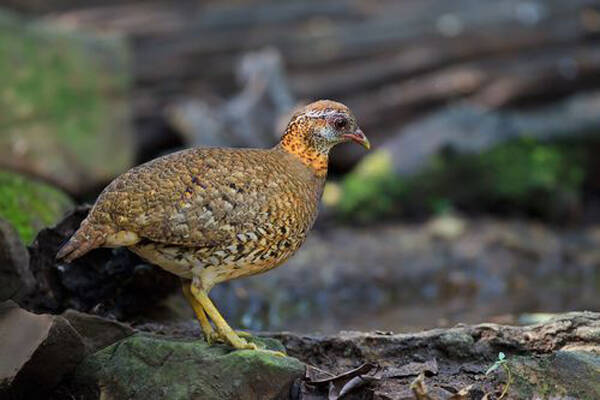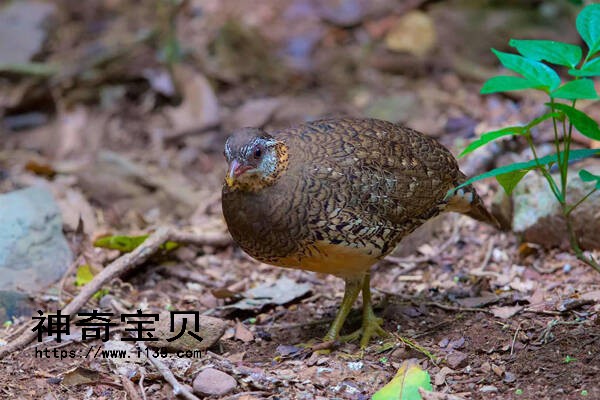Arborophila chloropus
IUCN
LCBasic Information
Scientific classification
- name:Arborophila chloropus
- Scientific Name:Arborophila chloropus,Green-legged Partridge
- Outline:Landfowl
- Family:Chickeniformes Pheasants Arborophila
Vital signs
- length:25-28cm
- Weight:200-300g
- lifetime:No textual research information is available
Feature
The top of the head is olive brown to the back of the neck, the corners of the mouth are brown, the legs and feet are green
Distribution and Habitat
It is found in Cambodia, China, Lao People's Democratic Republic, Myanmar, Thailand and Vietnam.
Green foot mountain tridges live in the mountain evergreen forest and scrub area at an altitude of 900-1500 meters, especially in the dense forest and forest scrub area of the low mountain hills and mountain foothills, and also in the secondary forest and small jungle near farmland. It is also commonly found in oat fields and sparse deciduous forests.
Appearance
Green foot arborophila forehead, eyes first, white brow lines, black feathers; Olive brown from crown to nape; The back is also olive brown, but darker, with a black tip patch forming a wavy patch on the back, and irregular black stripes on the lower back and waist with brownish-red intersperses. The upper inner cover and flying feathers of the wings are the same color as the lower back. Outer cover light sandy brown, mixed with black spots; Secondary flight feathers dark brown, outer mixed with brown and black brown mixed edges; Primary cover feather Lew primary flying feathers several pure black brown, only the outer tip slightly mixed with brown small spots. Chin, throat and side of head are white and brown, with black end spots; The neck had a rusty yellow collar tinged with black; Chest and back the same color, no markings on the upper chest, the lower chest and back the same wavy pattern; The upper abdomen is deep rusty yellow, the back is yellowish white; The sides are also rust
Details
The Green-legged Partridge (Arborophila chloropus) has four subspecies.

Partridges are usually found in pairs or in groups of 3-5 individuals. Temperament is extremely timid, often hiding under the forest, shrubland or grass, usually rarely take off, often in the underforest shrubland and grass activities and runs. It usually runs short distances after being frightened, then crouches under bushes and other concealments, only taking off suddenly when it is very critical. The activity is frequent, high and rapid, and the loud whistle consists of a series of single notes that get faster and faster, followed by a series of flat rising and falling tones, and finally a series of frantic rising and falling tones that suddenly end.
Partridges often roam in pairs or small groups, picking through leaf litter on brush floors in search of insects and seeds. They usually run only a short distance and then crouch under some cover. When frightened, it suddenly takes off and lands not far away. It lives in the mountain evergreen forest, mainly feeds on insects such as beetles, termites and small invertebrates as well as plant seeds. It often forages in leaf litter on the understory. At noon, when the weather is hot, rest or drink water by the stream.

The breeding period is from April to June, and the nest is built on the underforest ground in the mountain forest between 1500 and 4000 meters above sea level, using natural pits on the ground or by the female bird to dig a small pit in the ground. The nest is often surrounded by lush shrubs or understory vegetation, which is not easy to see, but sometimes the nest is built in the understory vegetation is sparser and not very hidden. The breeding status of the partridge is unknown. The brooding is mainly done by the female, and the male is responsible for the vigilance. Soon after hatching, the chicks follow their parents.
Partridge is found only in Xishuangbanna tropical rain forest in Yunnan Province. Since the late 1950s, this rainforest has been a large number of cultivation planting rubber trees, the original natural landscape has been beyond recognition, coupled with a large number of planting workers to move in, build houses, plant vegetables, chop wood for cooking and further deforestation, so the green foot mountain partridge habitat was destroyed by destruction.
It was included in the List of Land Wild Animals under State Protection that are beneficial or have important economic and scientific research value (Item 89) issued by the State Forestry Administration of China on August 1, 2000.
Listed in the International Union for Conservation of Nature Red List of Threatened Species (IUCN) for 2016 ver 3.1 - Not Threatened (LC).
Listed in China's "National Key Protected Wildlife List" (February 5, 2021) Level 2.
Protect wild animals and eliminate wild meat.
Maintaining ecological balance is everyone's responsibility!








